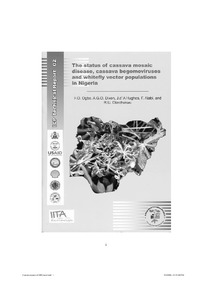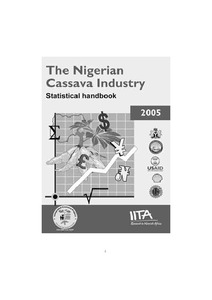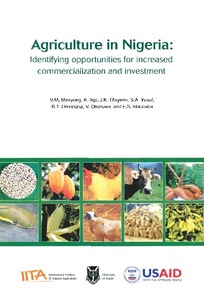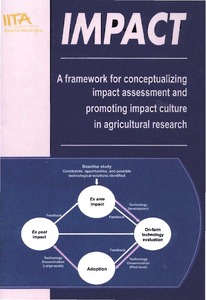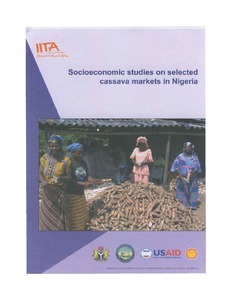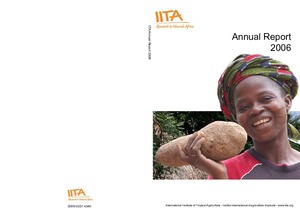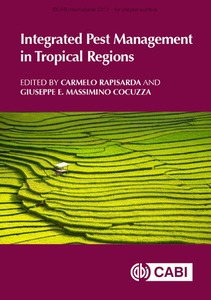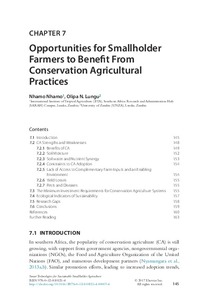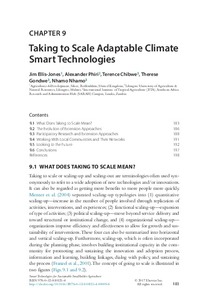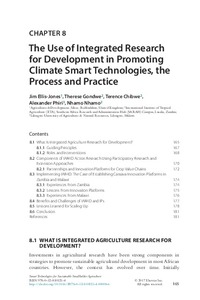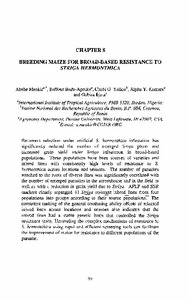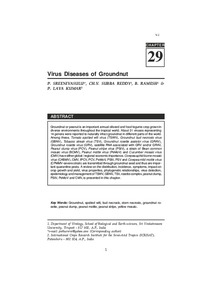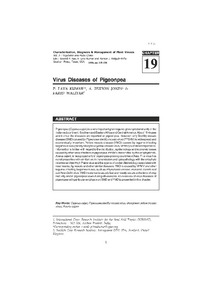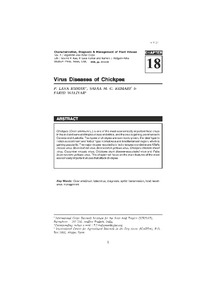Welcome to the International Institute of Tropical Agriculture Research Repository
Books and Book Chapters: Recent submissions
Now showing items 781-800 of 977
-
The status of cassava mosaic disease, cassava begomoviruses, and whitefly vector populations in Nigeria
(2005)A diagnostic survey was conducted in 2002 and 2003 to determine the status of cassava mosaic disease (CMD) and cassava mosaic begomoviruses in Nigeria and to ascertain if the virulent Ugandan variant of the East African cassava mosaic virus (EACMV-Ug2) is present in the country. The survey was an activity of a CMD project on measures to protect cassava production in Nigeria from potential devastating effects of a severe form of the disease. Routes were selected in states of the six geopolitical ... -
The economic impact of investments in cassava research in Uganda
(2007)Cassava plays a major role in both household and national food security in Uganda. However, cassava production in Uganda has been threatened by cassava mosaic disease. The government has made concerted efforts to evaluate, multiply and distribute new cassava planting materials in most districts. The new varieties outperformed the local varieties and quickly replaced them. An economic assessment of this programme using the benefit-cost approach revealed that the internal rate of return for this ... -
Targeting agricultural research for development in Tanzania: an example of the use of GIS for ex ante impact assessment at IITA
(2007)GIS targeting, combining a range of different datasets including climate, topography, population, protected areas, road networks, agricultural production, and markets, is becoming an important tool in planning agricultural research for development. The impact of agricultural investments can be maximized by targeting them to areas where biophysical conditions are optimal for selected crops, and where population densities and market access maximize the economic possibilities. Targeting can be tailored ... -
A framework for conceptualizing impact assessment and promoting impact culture in agricultural research
(2006)Assessing the impact of agricultural research can assist with setting priorities, providing feedback to the research programs, and demonstrating actual benefits of the products of agricultural research. Towards this end, many national and international agricultural research centers have institutionalized impact assessment. However, a number of conceptual and operational difficulties remain that limit the scope and depth of impact assessment work. The objective of this document is to develop a ... -
IITA Annual Report 2006
(2007) -
Integrated pest management in banana and plantain
(CAB International, 2017) -
Reducing risk of weed infestation and labor burden of weed management in cropping systems
(Elsevier, 2017)Weeds are a major biological yield reducing factor in most cropping systems in Africa. The annual cost of weed control has been estimated to be $4.3 billion in Africa. This figure is expected to increase as a result of climate change effects on weed species and ecological conditions for a range of weeds. Similarly, the labor burden that weeding imposes on farm families is expected to increase. Although a range of weed management practices have evolved over the past five decades, farmers still face ... -
Opportunities for smallholder farmers to benefit from conservation agricultural practices
(Elsevier, 2017)Conservation agriculture (CA) practices combine the use of soil cover, crop combinations, and reduced tillage. There has been widespread promotion of CA practices in southern Africa. The aim of this chapter is to take stock of the advances in understanding the CA systems and to define the benefits of CA to smallholder farmers and where it can best be applied. Research results have shown an improved understanding of how the systems impact production potential and an indicative direction of where ... -
Taking to scale adaptable climate smart technologies
(Elsevier, 2017)The strength of an innovation systems approach for Integrated Agriculture Research for Development (IAR4D) is based on a wide involvement of stakeholders, capacity building, planned progression of involvement of different actors, and the voluntary nature of participation. In this chapter, this concept is taken further showing that successful pilot initiatives can be taken to scale using and building on the same principles embedded in IAR4D. This requires an understanding of research and development ... -
The use of integrated research for development in promoting climate smart technologies, the process and practice
(Elsevier, 2017)Integrated Agriculture Research for Development (IAR4D), based on the use of participatory research and extension and innovation system approaches, represents an action research process in support of development activities. This is a major shift from the traditional way of undertaking research, where researchers conceptualized and developed technologies and then passed them on to extension, who were then expected to take new technologies to farmers. Instead, innovation system approaches involving ... -
Breeding maize for broad-based resistance to striga hermonthica
(World Scientific Publishing, 2007-06)Recurrent selection under artificial S. hermonthica infestation has significantly reduced the number of emerged Striga plants and increased grain yield under Striga infestation in broad-based populations. These populations have been sources of varieties and inbred lines with consistently high levels of resistance to S. hermonthica across locations and seasons. The number of parasites attached to the roots of diverse lines was significantly correlated with the number of emerged parasites in the ... -
Virus diseases of groundnut
(2008)Groundnut or peanut is an important annual oilseed and food legume crop grown in diverse environments throughout the tropical world. About 31 viruses representing 14 genera were reported to naturally infect groundnut in different parts of the world. Among these, Tomato spotted wilt virus (TSWV), Groundnut bud necrosis virus (GBNV), Tobacco streak virus (TSV), Groundnut rosette assistor virus (GRAV), Groundnut rosette virus (GRV), satellite RNA associated with GRV and/or GRAV, Peanut clump virus ... -
Virus diseases of pigeonpea
(2008)Pigeonpea (Cajanus cajan) is a very important grain legume grown predominantly in the Indian subcontinent, Southern and Eastern Africa and Central America. About 15 viruses and 4 virus-like diseases are reported on pigeonpea. However, only Sterility mosaic disease (SMD) caused by Pigeonpea sterility mosaic virus (PPSMV) is widespread and economically important. Yellow mosaic disease (YMD) caused by legume-infecting begomoviruses (mostly Mungbean yellow mosaic virus, MYMV) is of minor importance. ... -
Virus diseases of chickpea
(2008)Chickpea (Cicer arietinum L.) is the most important pulse crop and is an important source of dietary protein. It is mainly grown in Indian subcontinent, Ethiopia, Turkey, Mexico, and some regions around the Mediterranean and in the Middle East. Recently the crop is gaining prominence in Canada and Australia. Two types of chickpea are grown commonly, the ‘desi’type in Indian subcontinent and ‘kabuli’ type in West Asia and Mediterranean region, and this type is gaining popularity. Several viruses ...

